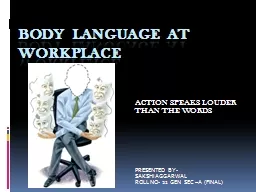

ACTION SPEAKS LOUDER THAN THE WORDS PRESENTED BY SAKSHI AGGARWAL ROLL NO 21 GEN SEC A FINAL INTRO Its about matching what we see with what we hear in the environment surrounding the situation amp drawing a probable conclusion ID: 581887
Download Presentation The PPT/PDF document "BODY LANGUAGE AT WORKPLACE" is the property of its rightful owner. Permission is granted to download and print the materials on this web site for personal, non-commercial use only, and to display it on your personal computer provided you do not modify the materials and that you retain all copyright notices contained in the materials. By downloading content from our website, you accept the terms of this agreement.
Slide1
BODY LANGUAGE AT WORKPLACE
ACTION SPEAKS LOUDER THAN THE WORDSPRESENTED BY-SAKSHI AGGARWALROLL NO- 21 GEN SEC –A (FINAL)Slide2
INTROIt's about matching what we see with what we hear in the environment surrounding the situation & drawing a probable conclusion.
Slide3
INTRODUCTIONSlide4
Origin of body language
It's believed that the ability to read a person's attitudes & thoughts by their behavior was the original communication system used by humans before spoken language evolved. Body language is a product of both genetic and environmental influences. Blind children will smile and laugh even though they have never seen a smile.Slide5
TYPES OF BODY LANGUAGE
1) FACIAL EXPRESSIONSSlide6
2)GESTURES
MOVEMENTS OF THE HANDS, THE HEAD OR THE BODY. GESTURES ARE CULTURALLY BASED. Slide7
3)BODY MOVEMENTS AND POSTURES
POSTURE PRETAIN TO THE MANNER IN WHICH WE CARRY OURSELVES.Slide8
4)DRESS AND ACCESSORIES
IT INFORMS THE PEOPLE ABOUT US. PEOPLE JUDGE YOU BY THE WAY YOU DRESSED, THE COLOUR YOU DRESS, BY YOUR SHOES ECT. Slide9
5)BODILY CONTACT
1)POSITIVE AFFECT- FOR APPRECIATION, AFFECTION, REASSURANCE OR NURTURANCE . 2)PLAYFUL- FOR HUMOUR AND PLAFULNESS. 3)CONTROL- TO DRAW ATTENTION OR INDUCE COMPLIANCE. 4)RITUALISTIC- RITUALISED REQUIREMENTS LIKE GREETINGS AND DEPARTURES. 5)TASK RELATED- TO ACCOMPLISH TASKS.Slide10
6) SILENCE- SILENCES ARE ARE NOT ABSENCE OF COMMUNICATION. THEY ARE INTEGRAL PART OF INTERPERSONAL COMMUNICATION.
Slide11
7) EYES
Women are far more perceptive than men, that's what's commonly referred to as "women's intuition
". Women have a great ability to pick up non-verbal signals as well as having an accurate eye for small details.Slide12
8)SPACETYPES OF SPACE
INTIMATE SPACE LANGUAGE
PERSONAL SPACE LANGUAGE
SOCIAL SPACE LANGUAGE
PUBLIC SPACE LANGUAGE
I8 INCHES
I8 IN
TO 4 FEET
4 FEET TO 12 FEET
12 FEET TO THE RANGE OF SEEING AND HEARINGSlide13
MEANING OF FEW BODY LANGUAGE TRAITSSlide14
1)HandsThe most expressive body part
Palms down: Confidence, assertiveness, dominance.Palms up: Vulnerability, nonaggression, congeniality, humility, uncertainty.Slide15
Vise-strength handshake
: More common in the United States.Fingertip handshake: Hands not locked "web to web." Shows less emotional connection.Slide16
2)Lips
The most emotional body part Lip compression: Indicates even slight resistance, negative feelings or stress.
Slight drooping:
May be the first sign of unvoiced grief, sadness or disappointment.Slide17
3)Shoulders
Attached only to collarbone; flexible and expressiveShrugging: Indicates self-doubt and uncertainty. Slide18
4)Eyes
Reveal how we feel about and relate to people Eye contact: Looking directly into eyes causes heart rate and blood pressure to rise. Can be regulated by maintaining gaze intermittently, often for three seconds or less before glancing away. Even babies do this.
Cultural variations:
Japanese listeners often focus on speaker's neck to avoid eye contact; U.S. listeners focus on eyes.Slide19
Good Body Language
Leaning forward slightly - This communicates interest in what others have to say. Slide20
Make eye contact –
If no eye contact is made, this can signal deception or suspiciousness. Also, be careful on your judgments if someone does not make eye contact with you. Slide21
Mirror the body language of the other person
This shows that you are “in tune” with what the other person has to say and will make them feel at home and relaxed. Use discreetly though, otherwise you could seem to be making a mockery of them. Slide22
Sitting or standing upright with relaxed shoulders and arms -
This is good assertive body language. While you are showing powerfulness through standing upright, you are showing you are open to ideas and suggestions with your relaxed posture. Slide23
Respect the space of others
This will avoid nervous tension and allow a better atmosphere to communicate in. Slide24
Just like there is positive body language for the workplace, there are also little things we do that affect other's negatively. It may be things we don't notice - like shrugging after presenting a proposal or fidgeting with a pen during an interview. The best thing to do is to videotape yourself and then watch the tape over and over to be able to tell when you are doing something that would annoy another person.Slide25
Bad Body Language
Tightly crossed arms Rolling on your heels
Lazing about on a chair
Shoulder shrugs
Playing with your hair
Pulling your ear
Touching your face
Foot tapping or pen drumming
Clenching your fists
Slide26
5 Mistakes Reading Body Language in the Workplace
1) They forget to consider the context.2) They try to find meaning in a single gesture.3) They are too focused on what's being said.
4) They don't know a person's baseline.
5) They judge body language through the bias of their own culture
: Slide27
So just rememberBody language cues are undeniable. But to accurately decode them, they need to be understood in context, viewed in clusters, evaluated in relation to what is being said, assessed for consistency, and filtered for cultural influences. If you do so, you'll be well on your way to gain the nonverbal advantage!Slide28
A SMALL CLASS EXERCISESlide29
So What Does This Mean?Slide30
So What Does This Mean?Slide31
So What Does This Mean?Slide32
So What Does This Mean?Slide33
conclusionBody Language is the most important part
OF COMUNICATION AT WORK PLACE.THE GOOD BODY LANGUAGE CAN BE LEARNED AND IT IS NECESSARY TO PRACTICE THESE TRAITS TO INHERENT THEM PERMANENTLYSlide34Slide35Slide36
Sources: Anthropologist David Givens; "The Nonverbal Dictionary of Gestures, Signs and Body Language Cues.“
Business Communication -Asha KaulBusiness Communication-Jin kaushal